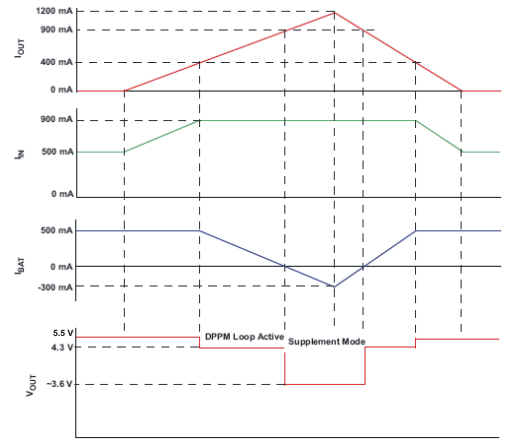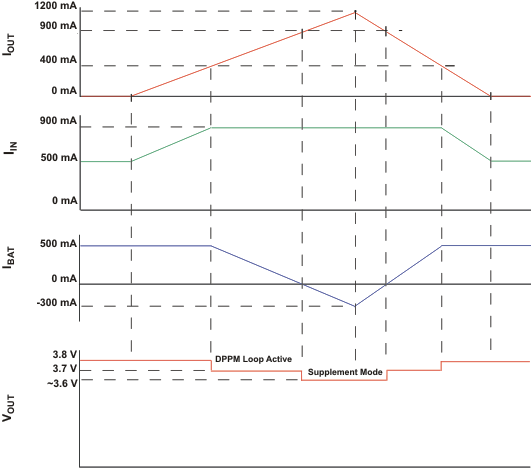ZHCSKH8C December 2009 – December 2019 BQ24072T , BQ24075T , BQ24079T
PRODUCTION DATA.
- 1 特性
- 2 应用
- 3 说明
- 4 修订历史记录
- 5 说明 (续)
- 6 Device Options
- 7 Pin Configuration and Functions
- 8 Specifications
-
9 Detailed Description
- 9.1 Overview
- 9.2 Functional Block Diagram
- 9.3
Feature Description
- 9.3.1 Undervoltage Lockout (UVLO)
- 9.3.2 Overvoltage Protection (OVP)
- 9.3.3 Dynamic Power-Path Management
- 9.3.4 Battery Charging
- 9.3.5 Charge Current Translator
- 9.3.6 Battery Detection and Recharge
- 9.3.7 Termination Disable (TD Input, BQ24072T)
- 9.3.8 Battery Disconnect (SYSOFF Input)
- 9.3.9 Dynamic Charge Timers (TMR Input)
- 9.3.10 Status Indicators (PGOOD, CHG)
- 9.3.11 Thermal Regulation and Thermal Shutdown
- 9.3.12 Battery Pack Temperature Monitoring
- 9.4 Device Functional Modes
-
10Applications and Implementation
- 10.1 Application Information
- 10.2
Typical Applications
- 10.2.1
Using the BQ24075T, BQ24079T to Disconnect the Battery from the System
- 10.2.1.1 Design Requirements
- 10.2.1.2
Detailed Design Procedure
- 10.2.1.2.1 Program the Fast Charge Current (ISET):
- 10.2.1.2.2 Program the Input Current Limit (ILIM):
- 10.2.1.2.3 Program 6.25-hour Fast-Charge Safety Timer (TMR):
- 10.2.1.2.4 TS Function:
- 10.2.1.2.5 CHG and PGOOD LED Status:
- 10.2.1.2.6 Processor Monitoring Status:
- 10.2.1.2.7 System ON/OFF (SYSOFF):
- 10.2.1.2.8 Selecting IN, OUT and BAT Capacitors
- 10.2.1.3 Application Curves
- 10.2.2 BQ24072T in a Host Controlled Charger Application
- 10.2.1
Using the BQ24075T, BQ24079T to Disconnect the Battery from the System
- 11Power Supply Recommendations
- 12Layout
- 13器件和文档支持
- 14机械、封装和可订购信息
9.4.1.3 Battery Supplement Mode
While in DPPM mode, if the charging current falls to zero and the system load current increases beyond the programmed input current limit, the voltage at OUT reduces further. When the OUT voltage drops below the VBSUP1 threshold, the battery supplements the system load. The battery stops supplementing the system load when the voltage at OUT rises above the VBSUP2 threshold.
During supplement mode, the battery supplement current is not regulated (BAT-FET is fully on), however there is a short circuit protection circuit built in. demonstrate supplement mode. If during battery supplement mode, the voltage at OUT drops VO(SC2) below the BAT voltage, the OUT output is turned off if the overload exists after tDGL(SC2). The short circuit recovery timer then starts counting. After tREC(SC2), OUT turns on and attempts to restart. If the short circuit remains, OUT is turned off and the counter restarts. Battery termination is disabled while in supplement mode.
 Figure 21. BQ24075T, '79T DPPM and Battery Supplement Modes
Figure 21. BQ24075T, '79T DPPM and Battery Supplement Modes
(VOREG = 5.5 V, VBAT = 3.6 V)
